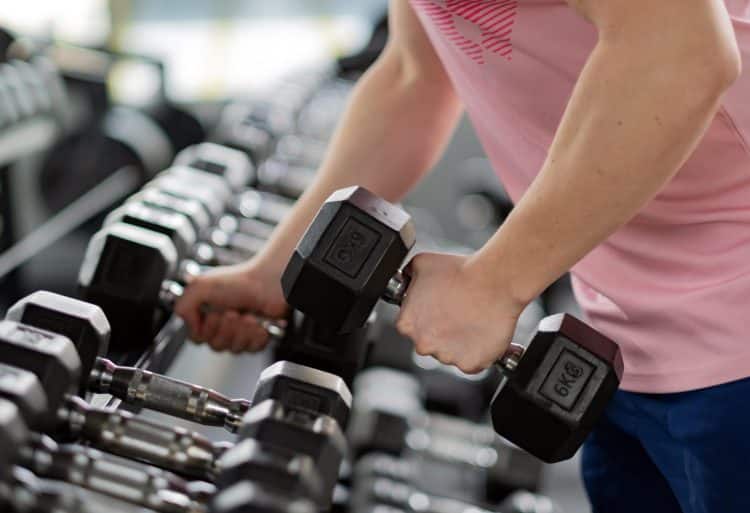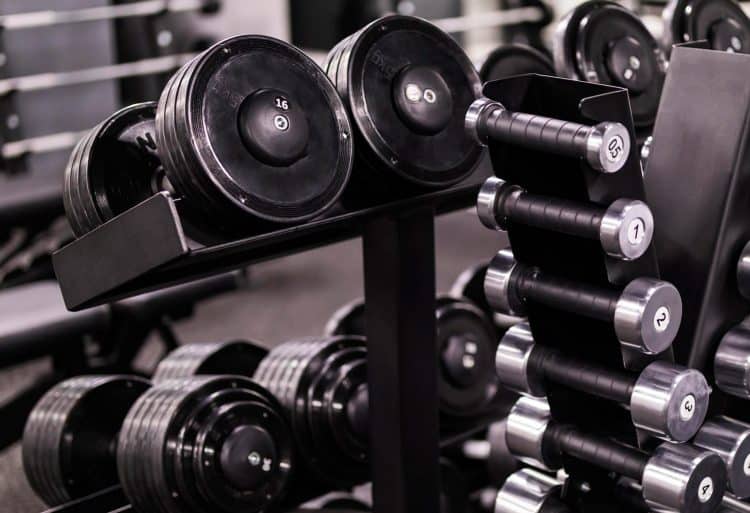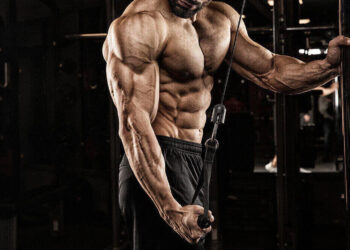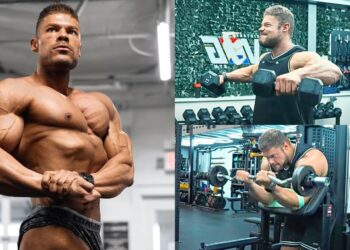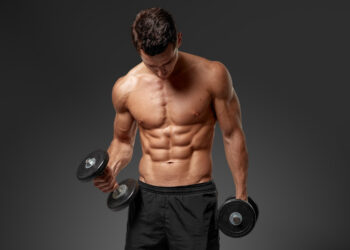Strength and bodybuilding can often seem to be complicated subjects. For example, trying to find a definitive answer to the question “how should I train” can leave you feeling like you are looking for a needle haystack.
That’s because fitness experts LOVE to contradict one another, promoting one “secret” method while dismissing everything else.
Looking for answers in scientific studies probably won’t help much, either, as many are contradictory. For example, one study may say you need to do twenty sets a week for muscle growth, while others may report that eight sets are all you need.
Why all this confusion?
The answer is simple – pretty much everything works!
High reps with light weights, low reps with heavy weights, training to failure, training short of failure, split routines, full-body routines, freeweights, calisthenics…all of these training methods can produce gains in muscle mass and strength, providing you do it consistently and with sufficient intensity.
Level Up Your Fitness: Join our 💪 strong community in Fitness Volt Newsletter. Get daily inspiration, expert-backed workouts, nutrition tips, the latest in strength sports, and the support you need to reach your goals. Subscribe for free!
In most cases, the “best” training solution is the one that you can stick with. Not for a week or a month but for the many years it takes to make significant progress.
So, for this article, we’re going to give you an upper-body dumbbell workout you can do at home or at the gym. You’ll need an adjustable bench too, but that’s it. This is a very excuse-free workout!
There Ain’t Nothing Dumb About Dumbbells!
A lot of people are quick to dismiss dumbbell-only training, believing that it is in some way inferior to using barbells. While it’s true that a barbell may mean you can lift heavier weights, dumbbells offer many benefits and can be just as effective.
Their advantages include:
Safety
Getting stuck under a heavy barbell during bench presses can cause serious injury. If you cannot complete your rep, you could end up with the barbell crushing your chest or neck. This is much less likely with dumbbells.
If you are unable to complete a rep, simply lower your weights to the floor. You can’t do that with a barbell, and a failed rep of barbell bench presses can cause serious injury.
Increased range of motion
With no bar to hit your chest or shoulders during rows and presses, you can move your joints through a more extensive range of motion. This is good for joint mobility, flexibility, and muscle growth.
Fix left-to-right strength imbalances
Most people have one arm or leg that is stronger than the other. This is very normal. But, if that imbalance becomes too great, it can lead to postural abnormalities, lop-sided muscle development, and athletic performance issues. Training with dumbbells can highlight any imbalances and provide you with the means to fix them.
Do unilateral training
Most barbell and machine exercises are bilateral, i.e., they use two limbs. You can do most dumbbell exercises unilaterally, meaning using just one arm.
For example, you can do single-arm bench presses, overhead presses, and bent-over rows. Unilateral exercises allow you to focus more on the muscle you are training and can help strengthen your mind-muscle connection.
Effective workouts with less weight
Because you’ll need to work harder to stabilize dumbbells compared to a barbell, you’ll probably find that you won’t be able to lift as much weight. While that may seem like a disadvantage, it doesn’t have to be. In fact, it may be a good thing because less weight means less joint stress.
Less joint stress means fewer missed workouts because of injury, easier recovery, and you can train with more volume and frequency, producing better results.
Improve your balance and coordination
Lifting two weights instead of one will challenge your nervous system more than using a barbell or resistance machine. This will develop your balance and coordination. These fitness attributes are crucial in sports and can also help make everyday activities easier.
Variety
There are hundreds of different dumbbell exercises, and most of them can be performed using two hands, one hand, or even using an alternating arm action. However, some exercises are only possible with dumbbells – there is no barbell equivalent. Even if they are your only form of training, using dumbbells should never be boring!
So, if dumbbells (also spelled dumb-bells) are so good, why do they have the word dumb in their name?
Dumbbells are so-called because they were initially developed so that 18th-century English church bell ringers could practice their skills in silence and avoid disturbing the people nearby. They were literally “dumb bells,” with dumb being an old-fashion word for silent.
Dumbbells do have a couple of disadvantages too
First, for pressing exercises, it can be difficult to get heavy dumbbells into the correct starting position. Also, barbells are usually easier to use for exercises like squats and deadlifts.
That said, if you only have access to dumbbells, don’t worry too much about what you can’t do, and focus more on what you can. Ultimately, any exercise is better than no exercise, and you can still work all your major muscles using dumbbells.
Best Upper Body Dumbbell Workout
A lot of exercisers make the mistake of training without direction. They select exercises at random, work hard, and then wonder why they aren’t making progress.
While hard work is essential for building strength and muscle, you must also train smart. That means following a logical program that trains all your muscle groups equally and with an appropriate level of volume and intensity.
All the hard work in the world won’t do much for you if it is misdirected.
So, here is a structured, balanced dumbbell upper body workout for you to try. Do it twice a week on non-constitutive days, e.g., Monday and Thursday, to allow plenty of time for rest and recovery.
But, before you begin, remember that a good workout starts with a proper warm-up, and dumbbell training is no different. Prepare your body and mind for training by doing a few minutes of light cardio, such as jumping rope.
Then, when you feel warm and slightly out of breath, do some dynamic stretches and joint mobility exercises for the body parts you’re about to train. Finally, feel free to do 1-2 sets of the first pushing and pulling movements to complete your warm-up.
All done? Then let’s get to work!
| # | Exercise | Sets | Reps | Rest |
| 1 | Dumbbell paused bench press | 3 | 6-8 | 2 minutes |
| 2 | Single-arm Pendlay row | 3 | 6-8 | 2 minutes |
| 3 | Incline dumbbell fly and press | 2 | 8-10 | 90 seconds |
| 4 | Chest-supported dumbbell row | 2 | 8-10 | 90 seconds |
| 5 | Dumbbell push-ups (drop set) | 1 | AMRAP | N/A |
| 6 | Dumbbell pullover (drop set) | 1 | 10-12 | N/A |
| 7 | Iso-lateral dumbbell shoulder press | 2 | 8-10 | 90 seconds |
| 8 | Dumbbell lateral raise (drop set) | 2 | 10-12 | 60 seconds |
| 9 | Dumbbell concentration curl | 2 | 10-12 | 60 seconds |
| 10 | Dumbbell skull crusher | 2 | 10-12 | 60 seconds |
Exercise Descriptions
There are two ways to do any exercise – the right way and the wrong way. The right way provides plenty of muscle-building tension while minimizing stress on your joints and connective tissue. The wrong way is usually less effective and more likely to cause injury. So, with that in mind, always prioritize proper technique above weight or reps. Perfect your form, then gradually increase the load as you get stronger.
Follow these instructions to get the most from all the exercises in your dumbbell upper body workout.
1. Dumbbell paused bench press
Target muscle: Pectoralis major
Dumbbell paused bench presses make a little weight go a long way. This can be useful if you find it hard to get heavy dumbbells into position for bench presses or only have light or moderate-weight dumbbells to train with. The mid-rep pauses increase time under tension, making each rep harder by reducing the stretch-shortening reflex.
How to do it:
- Lie on the bench with a dumbbell in each hand. Hold the weights over your chest, palms facing down your body. Pull your shoulders down and back, brace your abs, lift your chest, and drive your feet into the floor for maximum stability.
- Bend your arms and lower the dumbbells down and out to your shoulders. Pause in this position for 2-3 seconds.
- Drive the weights back up to arm’s length and repeat.
2. Single-arm Pendlay row
Target muscles: Latissimus dorsi, trapezius, rhomboids
Pendlay rows, invented by US weightlifting and powerlifting coach Glen Pendlay, are usually done with a barbell but work equally well with dumbbells.
With this exercise, each rep starts with your weight(s) resting on the floor. Beginning from a dead stop means you cannot use momentum to lift the weight, making each rep a little more challenging.
Level Up Your Fitness: Join our 💪 strong community in Fitness Volt Newsletter. Get daily inspiration, expert-backed workouts, nutrition tips, the latest in strength sports, and the support you need to reach your goals. Subscribe for free!
How to do it:
- Place your dumbbell on the floor next to your bench. Lean forward and place one hand on the bench for support. Brace your abs and pull your shoulders down and back. Grab the dumbbell in a neutral grip.
- Without using your legs or jerking with your upper body, smoothly pull the dumbbell off the floor and up to your lower ribs.
- Lower the weight back to the floor, allow it to settle for 1-2 seconds and then repeat.
- Do the same number of reps with both arms.
3. Incline dumbbell fly and press
Target muscle: Pectoralis major
This exercise combines two moves in one to hit your chest from multiple angles. Using an incline bench emphasizes your upper pecs. Don’t go too heavy with this exercise. Instead, focus more on squeezing your muscles to generate maximum muscle-building tension.
How to do it:
- Set your bench to a 30-degree angle. Lie on it with your head uppermost and a dumbbell in each hand. Press the weights up to arm’s length and hold them over your chest, hands turned inward.
- Open your arms and lower the dumbbells out and down to the side to form a T shape. Take care not to hyperextend your shoulders.
- Raise the dumbbells back together above your chest.
- Next, bend your elbows and lower the dumbbells down to your shoulders.
- Press them back up again.
- That’s one rep – keep going!
4. Chest-supported dumbbell row
Target muscles: Latissimus dorsi, trapezius, rhomboids
Chest-supported dumbbell rows work your upper back while saving your lumbar spine from stress and strain. This gives you the freedom to focus on pushing your lats, traps, and rhomboids to their limit in complete safety.
How to do it:
- Set your bench to a 30-degree angle. Lie face down on your bench with your head uppermost. Hold a dumbbell in each hand and let your arms hang down from your shoulders. Pull your shoulders down and back, brace your core, and turn your palms inward.
- Bend your arms and pull the dumbbells up and into your lower ribs. Lead with your elbows, and keep your wrists straight.
- Extend your arms and repeat.
5. Dumbbell push-ups (drop set)
Target muscle: Pectoralis major
This push-up drop set is designed to fully fatigue your chest. You’re only going to do it once, so make sure you push yourself to failure before moving to the next easier variation. By the last drop set, your pecs should be exhausted.
How to do it:
- Place your feet on your bench and adopt the push-up position with your hands resting on your dumbbells. Brace your core and pull your shoulders down and back. Your body should be perfectly straight.
- Bend your arms and lower your chest down between your hands. Push yourself back up and repeat. Continue to failure.
- Next, drop your feet to the floor and rep out again. Do as many reps as possible.
- Finally, place your hands on the bench and do one more set of push-ups to failure.
6. Dumbbell pullover (drop set)
Target muscles: Latissimus dorsi, pectoalis major
Pullovers are a part chest and part lat exercise, so they make a great finisher to the chest and back part of your workout. You’ll be doing this exercise as a triple drop set, so line up three dumbbells, one heavy, one medium, and one light, in readiness.
How to do it:
- Lie on a flat bench and hold a single dumbbell over your chest. Brace your abs, plant your feet firmly on the floor, and pull your shoulders down and together.
- With only a slight bend in your elbows, lower the dumbbell back behind you until your biceps are level with your ears.
- Pull the weight back over your chest and repeat and continue until failure.
- Quickly switch your dumbbell for a lighter one and pump out more reps, again going to failure.
- Finally, grab your last dumbbell and rep out again. Well done – you’re finished!
7. Iso-lateral dumbbell shoulder press
Target muscles: Deltoids
Like your first exercise, paused dumbbell bench presses, this exercise is designed to make light to moderate weights feel much heavier. The alternating arm action will keep your muscles under constant tension and make every rep feel much more demanding than usual.
How to do it:
- Seated or standing as preferred, press your dumbbells overhead. Your palms should be facing forward. Brace your abs.
- Bend one arm, lower the weight to your shoulder, and then press it up again.
- Do the same movement on the opposite side.
- Continue alternating arms for the prescribed number of reps.
8. Dumbbell lateral raise (drop set)
Target muscles: Deltoids
Your final shoulder exercise is designed to completely exhaust your medial deltoids. You’ll be doing a drop set, so line up three pairs of dumbbells before you start – heavy, medium, and light. Drop sets are a very effective if intense hypertrophy training method.
How to do it:
- Hold a dumbbell in each hand and stand with your feet hip-width apart, knees slightly bent, and core braced. Pull your shoulders down and back, and hold your weights next to your thighs.
- With a slight bend in your elbows, raise the weights out to the side of your body to form a T shape. Lower your arms back down and repeat to failure.
- Then, grab the next lightest set of dumbbells and rep out again.
- Finally, using the lightest dumbbells, do one final set to failure.
- Yes, that deep burning in your shoulders is entirely normal!
9. Dumbbell concentration curl
Target muscles: Biceps
You’ve already worked your biceps pretty hard, albeit indirectly, during all your back exercises. That said, for localized growth, it’s also worth doing some isolation training for your arms to maximize hypertrophy.
According to the American Council on Exercise, or ACE for short, concentration curls are the best move for building bigger biceps (1), hence their inclusion in this workout.
How to do it:
- Sit on an exercise bench with a dumbbell in one hand. Lean forward, rest your triceps against your inner thigh, and let your arm hang down.
- Bend your elbow and curl the weight up to your shoulder. Extend your arm and repeat until you have completed the required number of reps.
- Switch arms and do the same number of reps on the other side.
Related: Concentration Curl Guide
10. Dumbbell skull crusher
Target muscles: Triceps
In the same way that all pulling exercises indirectly train your biceps, the same is true for pushing exercises and your triceps. This final exercise is designed to finish off your triceps to trigger greater hypertrophy. Dumbbell skull crushers are one of the best dumbbell triceps exercises you can do.
How to do it:
- Lie on your bench with a dumbbell in each hand. Press the weights up to arm’s length and hold them over your chest, hands turned inward. Pull your shoulders down and back, brace your abs, and plant your feet firmly on the floor.
- Keeping your upper arms vertical and stationary, bend your elbows and lower the weights down to the side of your head.
- Extend your arms and repeat.
- This exercise works best with light to moderate weights and medium to high reps. Heavy weights can strain your elbow joints.
Read also: Bodyweight Skull Crushers Guide
Frequently Asked Questions
1. Is this a cutting or bulking program?
The main difference between cutting and bulking is your diet rather than the workout you are following. For example, if you eat 300-500 calories above your TDEE (Total Daily Energy Expenditure), you should bulk up and build muscle.
In contrast, if you reduce your calorie expenditure to 300-500 calories BELOW your TDEE, you should burn fat and get leaner.
So, adjust your diet according to your body composition goal. Eat more to build muscle and less to lose fat. Train hard to stimulate muscle growth or preserve your existing muscle mass during your cutting diet.
2. Can I change any of the exercises?
Providing you use similar exercises, you are free to make changes to the programs. However, don’t increase training volume or use different rep ranges. Also, try and use similar exercises if you choose to make alterations.
For example, replacing dumbbell with barbell bench presses is fine, but doing dumbbell curls instead of chest-supported rows is not. Always remain faithful to the spirit of the workout.
3. How much weight should I use for each exercise?
We don’t know how strong you are, so it’s impossible to prescribe precise weights for you to lift. So, choose loads that take you close to failure within the specified rep range.
For example, if the program calls for 8-10 reps but you can do 15, your weight is too light. Conversely, if you can only do seven reps, it’s too heavy. Adjust your weights to keep you within the range mentioned in the plan.
4. I only have light dumbbells; what should I do?
One of the most important triggers for hypertrophy is training close to failure. In theory, it doesn’t matter if that failure occurs after six or 26 reps. Lower reps are more time-efficient, but if you only have light dumbbells, you’ll have to work with what you’ve got and do more reps to fatigue your muscles. Simply rep out to failure, even if that takes more reps than specified by the program.
5. Got any good leg workouts to go with this program?
Sure do! Use any of these workouts to balance your upper body training. Work your legs twice a week for the best muscle-building results!
- At-Home Leg Workouts for A Stronger Lower Body
- Dumbbells-only Leg Workouts for Shredded and Massive Legs
- Swiss Ball Leg Workout for A Strong, Functional Lower Body
- The Best 30-Minute Leg Workout for Massive Quads, Hamstrings, and Calves
- The Best Barbell-Only Leg Workout
Wrapping Up
Don’t see only having dumbbells and a bench to train with as a disadvantage. Instead, these low-tech training tools allow you to work every major muscle group in the comfort and safety of your own home.
Having dumbbells and a bench at home also mean you can work out anytime you like – your private gym is never shut!
Providing you train hard, eat right, and get plenty of rest and sleep, this upper body dumbbell workout will help you get stronger and more muscular.
References:
1- American Council on Exercise (ACE): ACE Study Reveals Best Biceps Exercises https://www.acefitness.org

